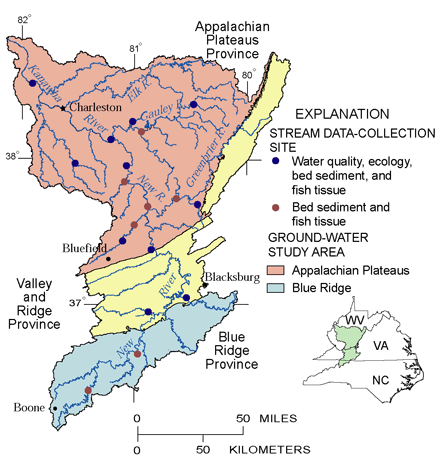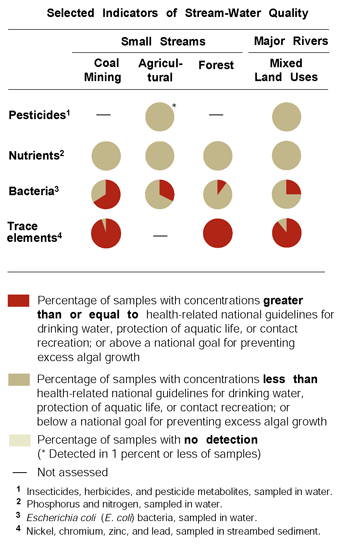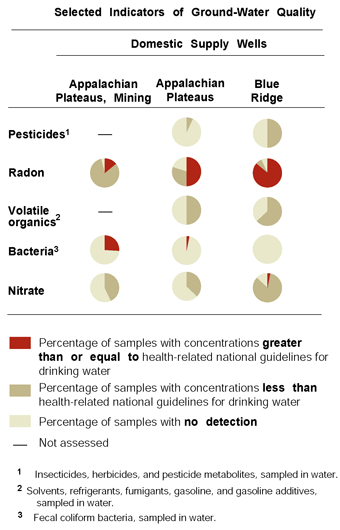SUMMARY OF MAJOR FINDINGS
 |
| The Kanawha-New River Basin is generally mountainous, forested, humid, and rural. Agriculture is concentrated in the southern half of the basin; major products are cattle and hay. Seven percent of all coal mined in the United States is produced from the Appalachian Plateaus Physiographic Province within the basin. |
The generally low population and intensity of agriculture and urban land uses throughout the Kanawha–New River Basin are reflected in low concentrations of nutrients and pesticides in streams and rivers.
Streams in the coal region of the Appalachian Plateaus Physiographic Province generally improved between about 1980 and 1998 with respect to pH, total iron, total manganese, and sedimentation. These improvements were among the regulatory goals of the Surface Mining Control and Reclamation Act of 1977 (SMCRA). Other unregulated factors, however, show the effects of continued mining. Mine drainage in the basin is rarely acidic but has high concentrations of sulfate, which decrease slowly after mining ends. Stream-bottom sedimentation in mined basins remains greater than in undisturbed basins.
- Streams draining basins that have been mined since 1980 show increased dissolved sulfate, decreased median bed-sediment particle size, and impaired benthic-invertebrate communities compared to streams not mined since 1980. (p. 5–11)
- In all basins studied where more than 100,000 tons of coal per square mile have been mined, the stream benthic-invertebrate community is impaired in comparison to rural parts of the basin where less than 10,000 tons of coal per square mile have been mined since 1980. Some basins in which the benthic-invertebrate community is impaired, however, were not heavily mined. Benthic invertebrates are sensitive indicators of many types of disturbance and respond to impairment of either stream chemistry or physical habitat. (p. 7–8)
-
Effects on stream benthic-invertebrate communities caused by coal mining were of similar magnitude to the effects caused by urban development and agriculture elsewhere in the Nation. (p. 11)
- Kanawha Falls is the upstream limit for the range of several fish species. Non-native fish continue to expand their range in tributaries of the New and Gauley Rivers. (p. 12–14)
- Escherichia coli (E. coli) bacteria concentrations exceeded the national guideline for public swimming areas in 26 percent of samples from major rivers and in 43 percent of samples from tributary streams, but no outbreak of waterborne disease was reported during 1991–98. Inadequate sewage treatment and manure management contribute to elevated E. coli concentrations. (p. 14–15)
- Volatile organic compounds (VOCs) continue to be detected in the Kanawha River downstream from the Charleston metropolitan area. (p. 16)
- Nickel, chromium, zinc, and certain toxic organic compounds were found in bed sediment in concentrations that could harm aquatic life. Elevated concentrations of cadmium, mercury, nickel, selenium, and zinc were measured in fish tissue at some sites. (p. 12)
| Major Influences on Streams and Rivers
|
Ground water in the Appalachian Plateaus and Blue Ridge Physiographic Provinces moves mostly in a network of narrow fractures within a few hundred feet of the land surface, and drains toward the nearest stream. Wells normally tap only a few of the many local fractures. The ridgetops bound each local aquifer, which generally are affected only by local contaminant sources. In small areas of the basin where caves and solution cavities in limestone bedrock are common, wells can have high yields but are susceptible to contamination from fecal bacteria, pesticides, and other toxic chemicals.
- Radon concentrations in the Blue Ridge were among the highest in the Nation. Almost 90 percent of wells sampled there exceeded the proposed U. S. Environmental Protection Agency (USEPA) primary drinking-water standard of 300 picocuries per liter (pCi/L). One-third of these wells contained more than 4,000 pCi/L, the proposed alternate drinking-water standard. Radon is a radioactive gas that forms during the decay of natural uranium. (p. 18–19)
- Modern well construction can prevent fecal bacteria from reaching drinking water in most areas of the basin. Bacteria were frequently detected only at older wells. (p. 19)
- Potentially explosive concentrations of methane were found in water at 7 percent of wells in the coal region of the Appalachian Plateaus. (p. 17)
- Nutrients, pesticides, and VOCs were detected in low concentrations throughout the basin. In the Blue Ridge, however, water from more than 50 percent of wells contained pesticides, an indication that the ground water is vulnerable to contamination. (p. 19)
- In the Appalachian Plateaus, iron and manganese concentrations exceeded USEPA drinking-water guidelines in at least 40 percent of the wells and in about 70 percent of wells near reclaimed surface coal mines. Elevated sulfate concentration and slightly acidic water were more common at wells within 1,000 feet of reclaimed mines than elsewhere. (p. 10 and 17)
 |
| Major Influences on Ground Water
|
| Table of Contents || Previous Section || Next Section || Glossary U.S. Geological Survey Circular 1204 Suggested citation:
|

